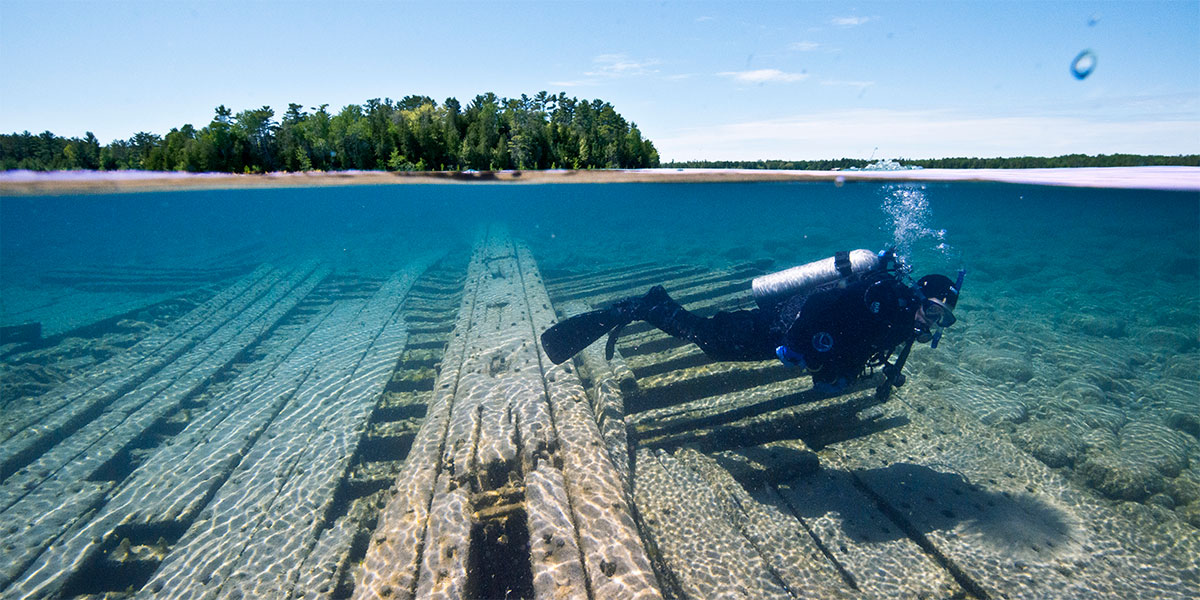Climate Change
Thunder Bay National Marine Sanctuary

Why is it a concern?
There are potential links between climate change in the Great Lakes and the deterioration of shipwrecks, but the topic remains under researched, and questions remain. For example, should climate change result in significantly decreased ice coverage on the Great Lakes, this would enhance evaporation and lead to a water level decline. As water levels drop, shallow water shipwrecks may become more exposed to air, waves and ice, thus accelerating natural decomposition. Nearshore shipwrecks in sandy lakebed environments may suffer increased deterioration as increasingly mobile sediment (due to a more dynamic environment created by lower water levels) variously exposes and buries sites. Moreover, the sudden occurrence of a shallow-water shipwreck exposed by shifting sediment makes for an exciting discovery, but one that is also potentially very accessible, and can lead to both intentional and unintentional human impacts. The effects of climate change on a delicately balanced and already stressed ecosystem could also have negative impacts by reducing water quality and, consequently, public accessibility to sanctuary resources. Climate change has also been identified as one of the most critical threats to Lake Huron’s biodiversity.
Overview of Research
| Project Name | PI and contacts | Links |
|---|---|---|
The Sweetwater Sea: Strategies for Conserving Lake Huron Biodiversity |
TNC Michigan |
|
The Nature Conservancy – Climate Change in the Great Lakes Region |
The Nature Conservancy |
|
National Wildlife Federation – Global Warming and the Great Lakes |
National Wildlife Federation |
http://www.nwf.org/Wildlife/Threats-to-Wildlife/Global-Warming/Effects-on-Wildlife-and-Habitat/Great-Lakes.aspx |
Great Lakes Environmental Research Lab – Integrated Physical and Ecological Modeling and forecasting Program |
NOAA / Great Lakes Environmental Research Lab |
Science Needs and Questions
- How do climate change impacts, such as water levels, affect shipwrecks within TBNMS?
- Which shipwrecks are most vulnerable to being exposed with changing water levels?
- How does climate change impact biological resources within TBNMS?
Education and Outreach Material
Office of National Marine Sanctuaries Climate Change Website
References
Franks Taylor, R., A. Derosier, K. Dinse, P. Doran, D. Ewert, K. Hall, M. Herbert, M. Khoury, D. Kraus, A. Lapenna, G. Mayne, D. Pearsall, J. Read, B. Schroeder. 2010. The sweetwater sea: an international biodiversity conservation strategy for Lake Huron – technical report. A joint publication of The Nature Conservancy, Environment Canada, Ontario Ministry of Natural Resources Michigan Department of Natural Resources and Environment, Michigan Natural Features Inventory Michigan Sea Grant, and The Nature Conservancy of Canada. 264 pp. with Appendices.
International Joint Commission Canada and the United States. 2001. 15th Biennial report on Great Lakes water quality, January 2001. Electronic document available from: http://www.ijc.org/rel/boards/watershed/15biennial_report_web-final.pdf.
Office of National Marine Sanctuaries. 2013. Thunder Bay National Marine Sanctuary Condition Report 2013. U.S. Department of Commerce, National Oceanic and Atmospheric Administration, Office of National Marine Sanctuaries, Silver Spring, MD. 80 pp.

